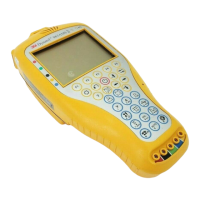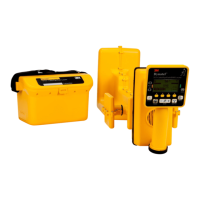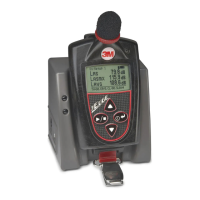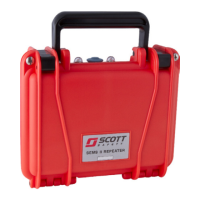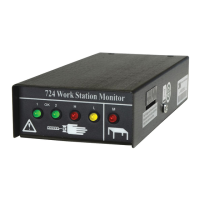78-8130-6150-0-F 25
andmetalpipes),butwouldrequireincreasedsweepdistanceseparationbetweenthe
transmitterandreceiver.
Note: If nothing is plugged into the Output Jack [T-6] of the transmitter, the
transmitter will automatically turn on the internal antennae, and the last frequency
used (8 kHz (12 Watt transmitter only), 33 kHz or 200 kHz) will broadcast in induction
mode.
The induction frequency can be changed by pressing the Frequency button on the
transmitter. For best results, the receiver should be at least 25 feet (7.6 m) away from
the transmitter to begin tracing the target path and have the gain set between 78-84%
when starting the sweep. This is used to establish a baseline gain threshold prior to
starting a sweep. When crossing a target pipe or cable, the bar graph will close and
the signal strength and audio response will increase. Attempting to trace the target
close to the transmitter may lead to false indications due to the receiver detecting the
large magnetic field radiating from the transmitter.
B. Sweeping (Active) Induction Mode Locating
Sweepinganareawiththe3MDynatel2200MSerieslocatorallowsthelocationof
multiplemetalliccablesandpipesburiedinanareawithoutdirectconnectorcoupler
accesstothecableorpipe.Thisapproachiseffectivebeforeanyexcavationtakesplace.
Notethatwhenspecificburiedobjectsneedtobeidentified,it'simportanttousethe
directconnectorcouplermethodforapplyingthesignal.Thiswillhelplimittheapplied
locatesignaltoaspecificfacilitythatprovidesmorepositionanddepthaccuracyalong
withaneffectiveidentification.Therearetwomaintypesof“noaccess”or“blind”
InductionSweeps;
Passive Sweeps: TheserequireonlytheuseoftheReceiverwithpassivefrequency
detectioncapability.Thismethodusesexistingexternalsignalsources,suchas60Hz/50
Hzforelectricpower,15kHztoapproximately30kHzforlowfrequencyradiosignals,
120Hz/100HzCPSimpressedcurrentCathodicProtectionsignalsandtheless
commonlyoccurringCATVsignalof31.25kHzNTSCwithCRTTVturnedon.
Active Sweeps: TheserequireboththeReceiverandTransmitterwithInduction
capability.Thismethodreferstousinga3MDynateltransmitterasthesignalsource
throughinduction,insteadofrelyingonpassivefrequenciesthatmayexistonthe
buriedconductorormetalpipe.ActiveInductionallowsfordetectingburiedcables
andmetalpipesintheabsenceofpassivesignalsandatdeepdepthsandshortsections.
3MDynateltransmittersprovideachoiceofinductionfrequenciesandoutputpower
levels.Higherinductionoutputpowerlevelsareneededfordetectingdeeperdepthsand
longerranges.The2200MSeries3Watttransmittersprovidestwoinductionfrequencies:
33kHzand200kHz.The12Watttransmitterprovidesthreeinductionfrequencies:8
kHz,33kHzand200kHz.The200kHzfrequencyiscommonlyusedfordeepercables/
pipesandthelowerfrequenciesareusedtogivelongerlocatedistances.The8kHz(low
frequency)inductionhelpsinlocatingshallowfacilities,suchasrisers.
C. Passive Sweeps
SelectSpecial(single)Peak(SplPk)modeonthereceiverandthenselectthefrequency
(source;forexample,power,LF,etc.)tobetraced.Passivesweepsatpowerfrequency
willdetectburiedpowercablesandconductorscarrying60Hz/50Hzpowersignalinthe
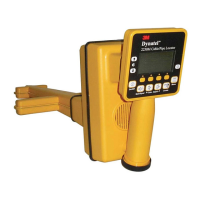
